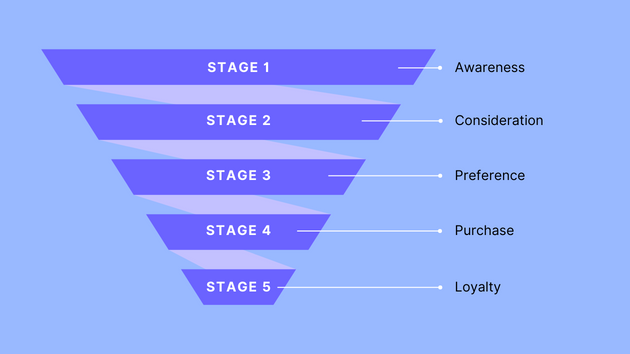How to Create Affiliate Marketing Funnel

A typical affiliate marketing funnel is a systematic approach that aims to convert potential leads into customers by guiding them through a series of well-defined steps. A streamlined affiliate marketing funnel can achieve significantly higher conversion rates compared to immediately directing cold traffic to a merchant or advertiser. This is particularly true when promoting higher-priced or intricate products. To achieve long-term success and optimize efficiency, it is crucial to prioritize providing value, establishing trust, and making appropriate product recommendations, all while incorporating tasteful elements of urgency and scarcity. By adopting this approach, you can minimize effort while maximizing sales in the long run.
What is an affiliate marketing funnel?
An affiliate marketing funnel offers an effective method to enhance your earning potential by capturing a wider range of leads, including those who may not be ready to make a purchase initially. Additionally, it provides an opportunity to develop long-term relationships with these leads, leading to increased recurring commissions over time.
An affiliate marketing funnel is a strategic process that affiliates use to guide potential customers through a series of steps to convert them into paying customers. It is a structured approach that involves various stages designed to capture the attention of prospects, build their interest, create a desire for a product or service, and ultimately prompt them to take action, such as making a purchase.

The key stages of an affiliate marketing funnel typically include the following:
- Awareness: Attracting the attention of potential customers by employing various marketing tactics such as content marketing, social media promotion, search engine optimization, or paid advertising. The goal is to make the target audience aware of the affiliate’s offerings and generate initial interest.
- Interest: Once prospects are aware of the product or service, the next step is to engage them and build their interest further. This can be achieved through compelling content, informative articles, videos, reviews, or personalized messaging that highlights the benefits and unique selling points of the offering.
- Evaluation and Decision: In this stage, the prospects are encouraged to evaluate the product or service and compare it with alternatives in the market. Affiliates may provide detailed product reviews, comparisons, case studies, or testimonials to help prospects make an informed decision.
- Conversion: Once prospects have decided to purchase, they are directed to the affiliate’s unique tracking link or landing page, where they can complete the transaction. This step usually involves a call-to-action (CTA) that prompts the prospect to take the desired action, such as making a purchase or signing up for a service.
- Follow-up and Retention: After the conversion, affiliates may continue to engage with customers to build loyalty and encourage repeat purchases. This can include providing after-sales support, offering additional value through exclusive content or promotions, and nurturing the customer relationship for long-term profitability.
Types of Affiliate Marketing Funnels
There are three main kinds of funnels you can use to promote affiliate products.
Course funnels enable you to develop affordable courses that serve as a gateway to your primary affiliate product. This strategy aims to increase conversions by encouraging customers to purchase a supplementary, low-priced course. Various platforms, including Systeme.io, Teachable, Thinkific, and Podia, provide the capability to host and strategically design your courses.
2. Webinar Funnels
A webinar funnel focuses on drawing in your desired audience, inviting them to participate in a complimentary webinar, and guiding them toward a specific goal. This goal may involve delivering valuable training while ultimately promoting your product or service.
3. Book Funnels
Among the various effective sales funnels, a free shipping book funnel proves to be successful, especially when you have a constrained budget for customer acquisition. The strategy involves offering physical books for free while charging only for shipping costs.
An affiliate marketing sales funnel should look something like this:
The initial stage involves driving traffic to your offer through blog posts optimized for search engine optimization (SEO), paid advertisements promoting a free offer, and leveraging social media platforms like Pinterest.
The second stage focuses on converting the traffic by offering a valuable freebie in exchange for their email address. This allows you to have more control over their journey and enables repeated selling opportunities.
In the third stage, you have the opportunity to engage and warm up your audience, building trust and rapport to improve conversion rates.
Finally, in the fourth and final stage, you can pitch your main offer to the now-warmed-up audience, maximizing the chances of a successful sale.
Benefits of the affiliate marketing funnel
As leads progress through the conversion stage, it becomes possible to refine targeting and segmentation based on their purchase behavior and engagement. This refinement allows for the customization of promotions, follow-up emails, and post-conversion engagement, resulting in maximized customer satisfaction and retention. By analyzing the data and insights obtained from customer actions, preferences, and feedback, affiliates can better understand their audience and deliver personalized experiences that resonate with their specific needs and interests. This targeted approach fosters stronger relationships with customers, increases their loyalty, and enhances the potential for long-term retention and repeat business.
An effective affiliate marketing funnel can significantly increase conversion rates. By delivering valuable information that addresses the pain points of potential customers, affiliates establish credibility and trust, making prospects more open to their recommendations. In the lead nurturing stage, affiliates share personalized content and valuable insights that highlight the benefits of the product or service. Post-conversion engagement is also important, as the funnel guides affiliates on how to continue nurturing the customer relationship and delivering value. This approach aims to encourage repeat purchases, cultivate customer loyalty, and drive long-term success.
1. Reach more prospects
During this stage, providing educational content for buyers increases the likelihood of driving conversions through your affiliate links in the future.
2. Boost your conversion rates
An affiliate marketing funnel offers the advantage of tracking every step, allowing you to identify and address any issues in the process. By monitoring engagement with emails and tracking conversions to the offer page, you can pinpoint areas where potential customers may lose interest or encounter obstacles, enabling you to make the necessary adjustments for improved results.
3. Bag repeat sales
One of the key advantages of building an affiliate marketing funnel, as opposed to simply adding links to a blog post or driving traffic directly to a sales page, is the ability to develop your own buyer’s list.
4. Increase brand trust and authority
The purpose of an affiliate funnel is to provide value to customers at every stage of their buyer’s journey. This approach ensures that even if they don’t make a purchase, there is no negative association because the focus is on delivering value rather than interrupting them on social media feeds like Facebook or Instagram.
5. Command higher affiliate commissions
Even if your traffic volume is not significant, if the traffic you send to merchants demonstrates above-average conversion rates and lower refund rates, you gain leverage to negotiate higher affiliate commissions.
5 Important Steps for Building an Affiliate Marketing Funnel

To achieve healthy conversion rates and consistent revenue, it is crucial to establish an effective affiliate marketing funnel. The initial step involves generating awareness by creating compelling blog posts and articles that offer valuable information, actionable insights, and solutions to address the target audience’s pain points. Leveraging popular social media platforms can help broaden the reach of the sales funnel and engage a wider audience. Additionally, paid advertising, particularly on platforms like Facebook and Instagram, can be effective in reaching beyond existing followers and subscribers to expand the audience further.
How to create a funnel for affiliate marketing
1. Clarify your target market.
Ask yourself questions like :
- What do you know about them?
- What things do they care about?
- What are their hopes and aspirations?
- What are their key frustrations and pain points?
The desired actions for prospects after going through your funnel include:
- Purchase specific products: The goal is for prospects to purchase specific products that align with their needs and preferences.
- Purchase a webinar: If you are conducting a webinar, the objective may be for attendees to purchase a product or service that you are promoting during the webinar.
- Achieve a specific outcome: The end goal may involve helping prospects achieve a specific outcome or result, such as gaining knowledge, solving a problem, or improving their skills.
Lead magnets can also be used to capture visitors’ contact information. These can take the form of ebooks, cheat sheets, or templates that offer substantial value and address the pain points of your potential customers, aligning with your niche.
Integrating your forms with email marketing software, such as GetResponse, allows for automating the lead-capturing process. This software enables you to segment your email list based on the source and create automated workflows, enhancing the efficiency and effectiveness of your email marketing campaigns.
4. Build a lead-nurturing email series
Email marketing is a crucial component of the affiliate sales funnel, as it enables consistent communication with leads throughout their journey. Building trust and guiding them toward the desired action, such as making a purchase, is facilitated through regular emails.
To create an effective email series, it is essential to select a reliable email marketing automation platform. While the primary objective of the series is to promote affiliate products, providing consistent value to subscribers is also crucial. Compelling subject lines help capture subscribers’ attention, and personalization adds a personal touch to the emails. Clear and persuasive calls to action should be included to prompt subscribers to take the desired action. Determining the appropriate frequency and timing for sending each email is also an important consideration.
By implementing these strategies, affiliates can leverage email marketing to engage and convert leads, ultimately driving affiliate product sales.
5. Stay in touch with your audience
After converting leads into customers, it’s important to continue nurturing the relationship in an affiliate funnel. Create dedicated post-purchase email campaigns that focus on delivering value, building relationships, and recommending relevant products. Send personalized thank-you emails, relevant blog posts, surveys for feedback, exclusive offers, discount codes, and occasional social proof or success stories. Additionally, promoting affiliate links on social media can help build an engaged community with your audience. This ongoing engagement and personalized approach can foster customer loyalty and drive further sales.
6. Monitor and optimize your funnel
Regularly analyzing each stage of your affiliate marketing funnel is crucial for identifying areas for improvement, optimizing strategies, and enhancing overall results. Tracking tools like Everflow and Voluum can provide valuable analytics to monitor your campaign at every stage.
It’s important to track key metrics such as website traffic, click-through rates, open rates, conversion rates, and bounce rates. This data will help you identify the most effective sources of traffic and conversions, whether it’s through opt-in forms, social media, affiliate landing pages, or email series.
Furthermore, analyzing visitor behavior throughout the funnel is essential. A/B testing can be used to experiment with different variations of website design, landing pages, and email campaigns to determine the most effective elements. Test and optimize headlines, design layouts, visuals, and call-to-action buttons based on the data and insights gathered.
By leveraging tracking tools and conducting thorough analysis, you can continuously improve your affiliate marketing funnel, drive better results, and maximize your success.
How to Drive traffic to your landing page
There are several effective methods to achieve this, such as utilizing advertising, which yields quick results, or employing social media marketing and search engine optimization (SEO), which may take longer to gain momentum but offer an excellent return on investment (ROI).
Drive traffic with ads
When it comes to ads, affiliate marketers often focus on driving traffic directly to the affiliate sales page or a bridge page. However, a more effective approach is to minimize the cost per click by directing them to a free page that serves as an entry point to your funnel. This strategy involves offering something of value that entices visitors to join your email list, enabling you to have multiple opportunities to sell to them in the future.
Use social media marketing
Another commonly used method to generate traffic for your free offer is through social media sharing. For instance, you can share a blog post on platforms like Twitter that promote various WordPress plugins.
Choose the right platform
When promoting an affiliate product like a house cleaning product, it is more suitable to focus on platforms like Pinterest or Instagram rather than LinkedIn. Additionally, you can leverage the data available in Google Analytics to determine the primary sources of your audience and tailor your promotional efforts accordingly.
Deliver value
Frequently, affiliate marketers make the error of solely sharing affiliate links on social media without providing any other content. If your social media presence is dominated by incessant promotional posts filled with product promotions and hashtags, it’s crucial to make a change in your approach.
Invest in Search Engine Optimization (SEO)
To develop a comprehensive SEO strategy, it is necessary to target and optimize various aspects of your website content.
To create a comprehensive SEO strategy, it is important to target different types of keywords:
Informational keywords: These keywords have higher search volumes and are ideal for list-building and providing valuable information to your audience. For example, “How to remove wine from a tablecloth.”
Comparison keywords: These keywords focus on comparing different products or options within a specific category. They help users make informed decisions. For example, “best red wine remover.”
Product keywords: These keywords target specific products or brands and are often used by users who are in the later stages of the buying process. For example, “Clorox review.”
Effectiveness and Measuring the Affiliate Funnel
Once you have created an affiliate marketing funnel, it is crucial to monitor and analyze its effectiveness and impact continuously. By examining key performance metrics, you can gain insights into the performance of each stage of the funnel.
- Point of Entry/ Amount of Entrance/ New Sessions
During the initial and second stages of the funnel, the primary focus is on creating awareness about the product or service. It is essential to monitor the number of new sessions and analyze the duration visitors spend on relevant web pages to evaluate their engagement levels.
- Conversion Rate
This can be quantified as a conversion rate, which is calculated by comparing the number of new visitors who perform the desired action (such as signing up for a service, providing their email for further communication, downloading an ebook, or requesting a product or service demo) to the total number of new visitors who land on a specific web page.
- Duration of the Sales Funnel Process
This refers to the duration that a potential customer spends within the affiliate marketing funnel, starting from when they enter (land on) the landing page until they reach the end goal, such as making a purchase or achieving the desired outcome. It also encompasses the number of steps or stages the customer must navigate through to progress from one stage of the funnel to the next.
Creating an affiliate marketing funnel doesn’t have to be complex. It involves selecting the appropriate offer, developing relevant opt-ins and bridge pages, setting up email automation, and creating landing pages to drive traffic. However, to maximize its effectiveness, the process doesn’t end there. Top affiliate marketers consistently track and monitor their funnels, seeking opportunities for improvement and optimization.
What You Need to Do to Be Successful at Affiliate Marketing Funnel
The most prevalent error individuals make in affiliate marketing is not treating it seriously. Instead of focusing on building a sustainable business, they prioritize making quick profits, which often leads to failure in the long run.
The lack of seriousness in affiliate marketing can manifest in several ways:
- Failing to establish themselves as experts in their niche.
- Neglecting to conduct proper research and due diligence to ensure the legitimacy of the products they promote.
- Treating their customers solely as sources of income rather than providing genuine value and building meaningful relationships.
Before entering the field of affiliate marketing, it is important to assess your willingness to make a long-term commitment. If your primary goal is to earn quick cash, it may be more suitable to pursue part-time employment or freelance work. However, if your objective is to establish a sustainable business, affiliate marketing can be a viable option, provided that you approach it with a serious and dedicated mindset.

So how can you differentiate yourself from the competition?
1. Become an Expert
This principle applies not only to the fitness products an individual sells but also to the fitness products they recommend. Regardless of the niche, it is essential to achieve something of value, freely share knowledge, and gather endorsements from others, such as relevant credentials, testimonials, and case studies.
Once you establish yourself as an expert, earning money through affiliate marketing becomes more manageable. People will be inclined to purchase from you rather than from a random individual selling the same product.
2. Build an Audience
The key aspect is to ensure that your content genuinely benefits potential customers by offering solutions to their existing challenges. It is important to note that building an audience is not solely about amassing a large number of email addresses.
Instead, it involves collecting the email addresses of potential customers and gradually establishing trust with them over time by consistently delivering value through both free and paid offerings.
This approach guarantees that people will prefer to purchase from you rather than from other affiliate marketers who are promoting the same product.
3. Provide Extra Value
To differentiate your offer from competitors, consider offering additional value through exclusive bonuses that customers can only access when purchasing the product through your affiliate link. The crucial aspect of this approach is to create a bonus that aligns with the affiliate product and provides tangible benefits to the customer. It should aim to make their life easier or enhance their overall experience with the product.
Affiliate marketing funnel example:
Here are some bonus ideas:
- A low-carb recipe ebook
- A video series that demonstrates each recipe
- A sample meal plan for 30-days
While it is possible to offer physical products as bonuses, it can be more challenging to make them financially viable due to lower profit margins compared to digital products. Therefore, it is often more effective to provide bonuses in the form of digital products such as ebooks, cheat sheets, reports, case studies, masterclasses, interviews, or live streams. These types of bonuses tend to work better in affiliate marketing as they offer higher profit margins and can be easily distributed to customers.
Mistakes in Affiliate Marketing Funnel That You Must Avoid
To achieve long-term success with affiliate marketing, it is crucial to avoid three common mistakes:
- Lack of Commitment: Treating affiliate marketing as a quick money-making scheme instead of a sustainable business venture can hinder your success. It requires dedication, effort, and a long-term commitment to building and growing your business.
- Lack of Value: Failing to provide genuine value to your audience can undermine your credibility and hinder your ability to earn trust. Focus on offering valuable content, solutions to problems, and building relationships with your audience.
- Lack of differentiation: standing out from the competition is essential in affiliate marketing. Merely promoting the same products as others without adding unique value or differentiation can make it challenging to attract and retain customers. Find ways to differentiate yourself, such as by offering exclusive bonuses or providing additional value to your audience.
It is crucial to conduct thorough research and promote only high-quality products that you genuinely believe in. Respect your subscribers’ attention and earn your place in their inbox by consistently sharing valuable content, providing helpful links, and answering their questions. While it is acceptable to send sales emails periodically, it is important not to overdo it. Many affiliate marketers make the mistake of continuously pitching different products that address the same problem to their email subscribers. Therefore, it is essential to avoid selling multiple products that essentially solve the same problem.
Characteristics of a good affiliate marketing funnel program
A good affiliate program should have:
- Clear and concise terms and conditions
- Offer competitive commission rates
- Provide quality marketing materials
- Have reliable tracking and reporting systems
- Offer timely payments and support to affiliates.
